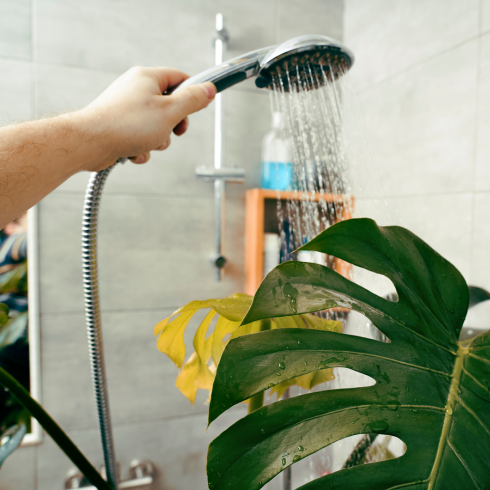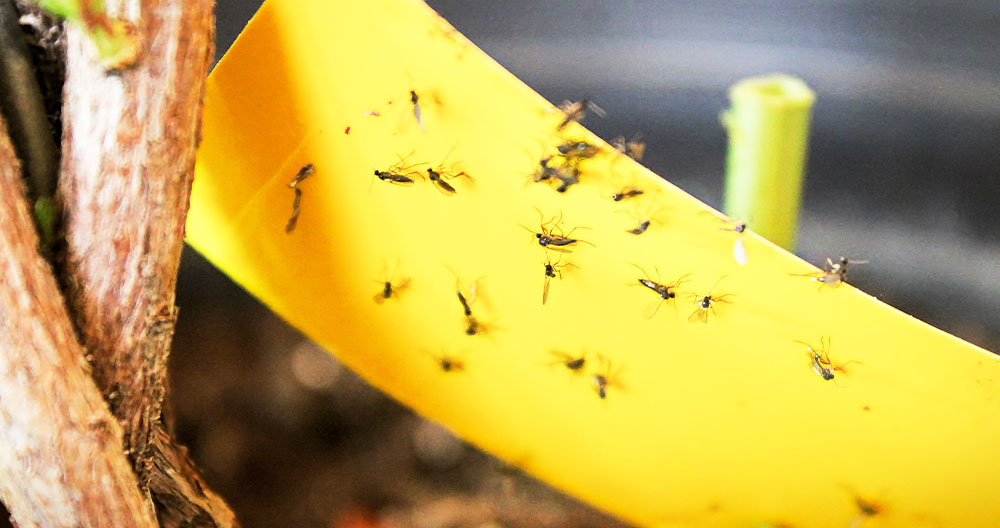
Pests are an annoying and almost unavoidable part of plant parenthood, unfortunately. Many pests feed on houseplants and can eventually kill your plant if you don’t get rid of them. There are various reasons for why pests occur:
One things to note is that unhealthy plants are more susceptible to pests. It's much easier to prevent pests than to treat them. Pests can be difficult to eradicate and it takes time, effort, and patience to get rid of them.
This section discusses pest prevention and treatment and addresses some of the most common pests.
There are various ways to prevent pests. First, examine potential plant purchases thoroughly. Check under the leaves and where the leaf meets the stem. These are common hiding places for pests. Additionally, separate new plants after bringing them home to prevent spreading to other plants.
If you move your plants outside for the summer, check the leaves as well as the soil and roots before bringing them back in.
Check on your plants every time you water for pests or signs of them. It's much easier to take care of a handful of pests on a plant than a full-on infestation. Take a quick peek at the leaves and stems.
Use neem oil, which is a natural solution for managing pests and acts as a repellent. Neem oil comes from the seeds of a neem tree. Some neem oils are ready to go, while others need to be mixed with other substances, like water or a mild liquid soap. Follow the directions for whatever product you use. Spray plants thoroughly, including the undersides of leaves. Apply neem oil on a regular basis every few months or so to keep pests at bay. Note that neem oil temporarily makes leaves more susceptible to burning. Apply this in the evening to prevent the leaves from being overexposed.

Neem oil from Happy Happy Houseplant
There are different treatment methods depending on the type of pest. A general rule of thumb for treating infested plants is to find a spot to quarantine your plant to prevent further spreading. This could be moving your plant into another room or getting a cover. You'll always want to wash your hands and any supplies before and after treating a plant with pests.
One method of treating pests is spraying your plant with water, which removes many pests. Be sure to spray all of the plant’s surfaces. It's a good idea to do this in the shower to avoid mess. This method is especially good for spider mites.

Another method is using isopropyl alcohol. Use a cotton swab dipped in rubbing alcohol to wipe off insects such as aphids, scale, and mealybugs. The alcohol kills the pests instantly.

You can also use insecticidal soap. This is a contact insecticide, meaning it’s only effective when it makes direct contact with pests. Once the soap solution dries, it has no effect against them. This soap is most effective against soft-bodied pests, such as aphids, mealybugs, immature scales, thrips, whiteflies, and spider mites. The solution can be obtained from garden stores and farm supply stores.
You will likely have to treat the plant several times no matter which treatment you use. This is because pests can be hidden or in the egg stage. You may need to treat your plant every week or so until the pests are gone.
If the above methods don't work, you may want to turn to a stronger chemical pesticide. This is a product that is watered down into the soil. Plants take the pesticide in through its roots, becoming toxic to the insects. It's better to use gentler means of control first. If you do use a chemical pesticide, ensure the pesticide is meant for indoor houseplants and is able to treat the specific pest. You may want to treat the plant outside rather than inside. This product can be obtained from garden centers and farm supply stores.
Neem oil can be used after the above treatments. The oil has properties to prevent future pests. While it doesn't kill on contact like insecticidal soap does, it can smother remaining pests.
Sometimes it can be best to get rid of the plant entirely in severe cases. This protects other plants from becoming infected and saves you effort and time.

Mealybugs are small, pale insects covered with a cotton-like white fluff. They move very slowly and are often found where the leaf attaches to the stem and underneath leaves. Mealybugs suck plant sap, damaging the plant.
Damage includes sticky honeydew on leaves (excreted from mealybugs as they feed), yellowing leaves, and stunted or distorted growth.
To treat mealybugs, remove them with a cotton swab dipped in isopropyl alcohol. You can also use insecticidal soap and follow this up with neem oil.

Spider mites are extremely small and are more closely related to spiders than insects. They suck plant sap.
Damage includes honeydew on leaves, silvery speckled leaves, and fine webbing on leaves.
To treat spider mites, rinse the plant thoroughly with water. Use insecticidal soap, followed by neem oil. Note that chemical pesticides usually don't work on them.
Aphids are small, pear-shaped insects that are usually green, but may be brown, black, yellow, or other colors. Adults may have wings and carry viruses. Aphids are usually found feeding on new growth or on the underside of leaves. They primarily suck plant sap, but some feed on roots.
Damage includes sticky honeydew on leaves, leaves yellowing and/or curling under, and stunted growth and deformed buds.
Treatment includes rinsing leaves with water and removing aphids with a cotton swab dipped in isopropyl alcohol. You can also use insecticidal soap and neem oil.

Scale are round, brown, slightly raised spots with a hard exterior. They can be categorized into two groups: armored and soft. Adult scales don't move and can almost look like part of the plant. They are usually found on stems and the undersides of leaves. Immature scales, called crawlers, move around until they find a place to settle and can't be seen with the naked eye. Crawlers suck plant sap.
Damage includes sticky honeydew on leaves and yellowing, patchy leaves.
Treatment includes removing scale with a cotton swab dipped in isopropyl alcohol or using your fingernail to scrape them off. You can also use insecticidal soap and neem oil.

Fungus gnats are small gnats that are usually seen in or near houseplant soil. The adults do not feed on plants but can be a nuisance to people. Larvae feed on soil matter or the roots, causing the plant to suffer.
Damage includes having small flies everywhere in the house.
Treatment includes placing sticky traps near the plant and around the house. Use a product that contains BTI, a biological control agent, which is applied to the soil through water to kill larvae. You can also let the plant dry out as much as possible to kill the larvae, and don't leave standing water in the saucer.